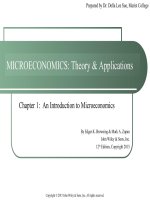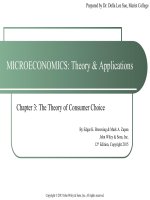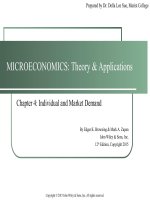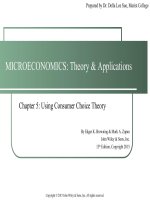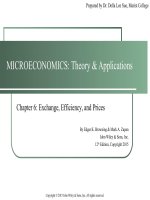Cost management accounting and control 6e by hansen mowen guan chapter 06
Bạn đang xem bản rút gọn của tài liệu. Xem và tải ngay bản đầy đủ của tài liệu tại đây (5.38 MB, 53 trang )
COST MANAGEMENT
Accounting & Control
Hansen▪Mowen▪Guan
Chapter 6
Product and Service Costing:
A Process Systems Approach
COPYRIGHT © 2009 South-Western Publishing, a division of Cengage Learning.
Cengage Learning and South-Western are trademarks used herein under license.
1
Study Objectives
1. Describe the basic characteristics of process costing, including cost flows,
journal entries, and the cost of production report.
2. Describe process costing for settings without beginning or ending work-inprocess inventories.
3. Define equivalent units, and explain their role in process costing.
4. Prepare a departmental production report using the FIFO method.
5. Prepare a departmental production report using the weighted average
method.
6. Prepare a departmental production report with transferred-in goods and
changes in output measures.
7. Describe the basic features of operation costing.
8. Explain how spoilage is treated in a process-costing system.
2
Process-Costing Systems:
Basic Operational and Cost Concepts
3
Process-Costing Systems:
Basic Operational and Cost Concepts
4
Process-Costing Systems:
Basic Operational and Cost Concepts
5
Process-Costing Systems:
Basic Operational and Cost Concepts
6
Process-Costing Systems:
Basic Operational and Cost Concepts
Basic features of a process-costing system
1. Homogeneous units pass through a
series of similar processes.
2. Each unit in each process receives a
similar dose of manufacturing costs.
3. Manufacturing costs are accumulated by
a process for a given period of time.
4. There is a work-in-process account for
each process.
continued
7
Process-Costing Systems:
Basic Operational and Cost Concepts
Basic features of a process-costing system (con’t)
5. Manufacturing cost flows and the
associated journal entries are generally
similar to job- order costing.
6. The departmental production report is
the key document for tracking
manufacturing activity and costs.
7. Unit costs are computed by dividing the
departmental costs of the period by the
output of the period.
8
Process Costing With No Beginning
or Ending Work-in-Process Inventories
Services that are homogeneous and
repetitively produced can use the processcosting approach.
Examples: check processing in a bank,
changing oil, dental cleaning, surgical
procedures
JIT manufacturing firms minimize inventories
and strive to reduce work-in-process
inventories to insignificant levels.
9
Process Costing With Ending
Work-in-Process Inventories
10
Process Costing With Ending
Work-in-Process Inventories
11
Process Costing With Ending
Work-in-Process Inventories
Cost of Production Report
• Analysis of the flow of physical units
• Calculation of equivalent units
• Computation of unit cost
• Valuation of inventories (goods transferred
out and ending work in process)
• Cost reconciliation
12
Process Costing With Ending
Work-in-Process Inventories
Nonuniform application of productive inputs
13
FIFO Costing Method
• Under the FIFO costing method, the
equivalent units and manufacturing costs
in beginning work in process are excluded
from the current-period unit cost
calculation.
• Thus, FIFO recognizes that the work and
costs carried over from the prior period
legitimately belong to that period.
14
FIFO Costing Method
15
FIFO Costing Method
Step 1: Physical Flow Analysis
16
FIFO Costing Method
Step 2: Calculation of Equivalent Units
17
FIFO Costing Method
Step 3: Computation of Unit Cost
Unit direct materials cost = $12,600 ÷ 70,000
= $0.18
Unit conversion cost = $3,050 ÷ 61,000
= $0.05
Unit cost = Unit direct materials + Unit conversion cost
= $0.18 + $0.05
= $0.23 per ounce
18
FIFO Costing Method
Step 4: Valuation of Inventories
19
FIFO Costing Method
Step 5: Cost Reconciliation
20
FIFO Costing Method
21
FIFO Costing Method
22
Weighted Average Costing Method
Step 1: Physical Flow Analysis
23
Weighted Average Costing Method
Step 2: Calculation of Equivalent Units
24
Weighted Average Costing Method
Step 3: Computation of Unit Cost
Unit direct materials cost = ($1,000 + $12,600) ÷ 80,000
= $0.17
Unit conversion cost = ($350 + $3,050) ÷ 68,000
= $0.05
Unit cost = Unit direct materials + Unit conversion cost
= $0.17 + $0.05
= $0.22 per completed unit
25




